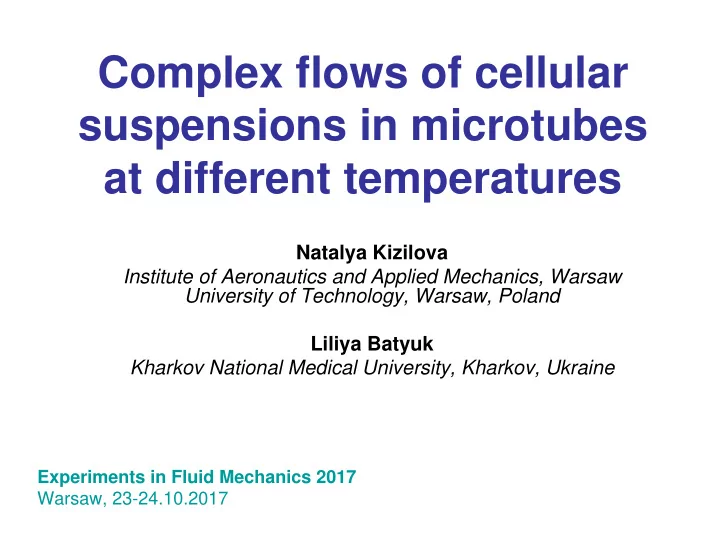

Complex flows of cellular suspensions in microtubes at different temperatures Natalya Kizilova Institute of Aeronautics and Applied Mechanics, Warsaw University of Technology, Warsaw, Poland Liliya Batyuk Kharkov National Medical University, Kharkov, Ukraine Experiments in Fluid Mechanics 2017 Warsaw, 23-24.10.2017
Outline 1. Microfluidic systems for blood processing 2. Blood flows through microtubes 3.1. Experiments 3.2. Fåhræus-Lindqvist effect 3.3. Copley-Scott Blair effect 3.4. Viscoplastic behavior 4. Mathematical modeling 5. Conclusions
Microfluidic systems for blood processing RBC ( d ~ 10 m )
Treatment/separation are based on • Mechanical properties: density, elasticity, flexibility; • Eelectric properties: charge, dielectric permittivity; • Magnetic properties: magnetic moment, magnetic permittivity; • Biochemical properties: adhesiveness, biomarkers.
UltraHighFrequency dielectrometry Erythrocytes of venous blood was washed out in 0.9% NaCl and diluted to 35% suspension. HF dielectrometer with f 9.2 HHz T , 0 47 C
Nanodiamonds in medicine
Radioprotective action of NDs • Experimental rats + X-ray radiation dose 5.8 Gy + suspension of NDs (C=0.01 with 0.9% NaCl) 5 days before radiation => blood sampling 30 days after radiation. Results: 1) radiation => dehydration of erythrocyte membranes (by 37%); 2) radiation+NDs => dehydration by 28.6%; 3) NDs without radiation => no changes (non-toxicity)
Blood flow measurements Tubes : d 100,300,500 m , L 1,2,3 cm Temperature : T 5 43 C , T 1 C Capillary vis cos imeter d ( 1.15 mm ) : ( ) T 4 p R q 0 8 L ( ) T bl q measured volumetric rate
Fåhræus-Lindqvist effect in suspensions 5 m d 500 m Stokes force, flow non-uniformity, inertia, Magnus force, unsteady viscous phenomena t d d d 3 3 2 F k R(v v ) k v k R (v v ) k R ( ) (v v ) k R (v v ) 1 2 3 4 dt d t
Copley-Scott Blair effect - Specific material-dependent adhesion at the inner wall of the tube; - Double electric layer and related electrokinetic phenomena; - Decrease in the apparent viscosity with decrease in the diameter and electrostatic forces.
Problem formulation dv 1 d p 1,2 r r dr dr L 1,2 dv 1 r 0 : 0 dr v 2 r R : v (R) (R) 0 2 r r R : v v 1 2 • Fåhræus-Lindqvist effect (boundary layer dv free of cells) 1 0 Bingham fluid dr • Copley-Scott Blair effect (h-layer of 1 adsorbed molecules/ions) (T) : d / dT 0 • Velocity slip boundary conditions (in (T) : d / dT 0 microtubes) h(T) : d h / dT 0 • Temperature dependencies of material parameters (T) : d / dT 0 0 0 (T) : d / dT 0
Fåhræus-Lindqvist for Newtonian fluids 2 2 v (r) (1 2a) (1 )(1 ) r , 1 2 v (r) (1 2a) r , 2 2 v R p 1,2 * 1 v , v , , , 1,2 * v 4 L R 1 2 a , a C Kn, Kn / R. R h 1 (1) (2) 4 q v rdr v rdr (1 4a) ( 1)(1 ) 0 q(T) q( (T), (T),a( T ) ) k T B For a Boltzmann gas K n , 0, 0, a 0. 2 2 d pR
Copley-Scott Blair + Fåhræus-Lindqvist for Newtonian fluids 4 3 2 2 3 4 q (1 h) 4( a)(1 h) 6 (1 )(1 h) 4 ( 1)(1 h) (1 ) , H 1 h , , , a , a C Kn, Kn / R. R R R 2
Copley-Scott Blair + Fåhræus-Lindqvist for Bingham fluids v (r), r [R h ,R h] 2 v(r) v (r), r [R*,R h ] 1 v (R*), r [0,R*] 1
Conclusions • Dielectric properties of red blood cells vary with temperature and their surfaces are influenced by serious diseases (cancer, stroke) • Steady flow of cellular suspensions through microtubes differs from those described by Poiseuille law • Among possible factors the transition to viscoplastic state may explain the experimentally observed temperature dependencies
Recommend
More recommend